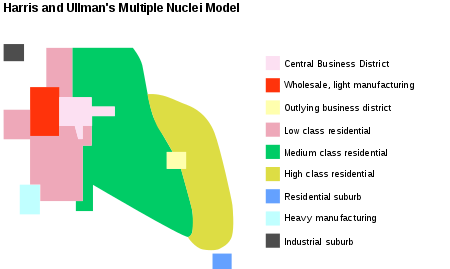Multiple nuclei model
Model in urban studies
The Multiple nuclei model is a basic model in modern urban planning.[1] It was developed by Chauncy Harris and Edward Ullman in 1945.[2] It was the third model in the Chicago school (architecture).[1] The main idea was that when a city reached a certain size its downtown central business district (CBD) could no longer serve the whole city.[3] Shops and offices move to the outer parts of the city. They grow and attract other businesses. This causes the areas around them to grow into new business centers.[3]

Related pages
changeReferences
change- ↑ 1.0 1.1 Encyclopedia of Human Geography, ed. Barney Warf (Thousand Oaks, CA: Sage Publications, 2006), p. 34
- ↑ Yan Liu, Modelling Urban Development with Geographical Information Systems and Cellular Automata (Boca Rattan, FL: CRC press, 2009), p. 9
- ↑ 3.0 3.1 Simon Ross; John Morgan; Richard Heelas, Essential AS Geography (Cheltenham: S. Thornes, 2000), pp. 277–278